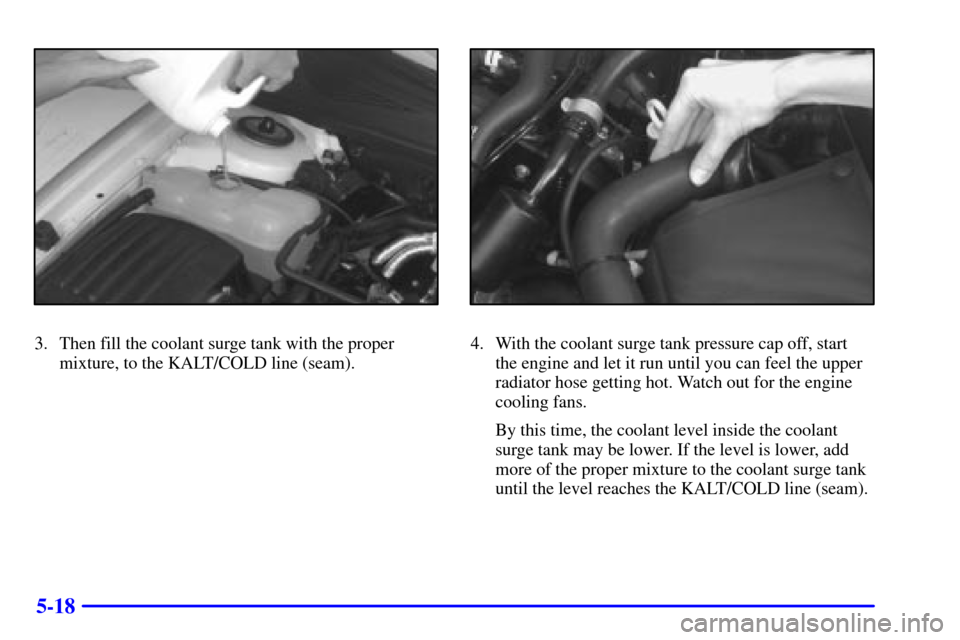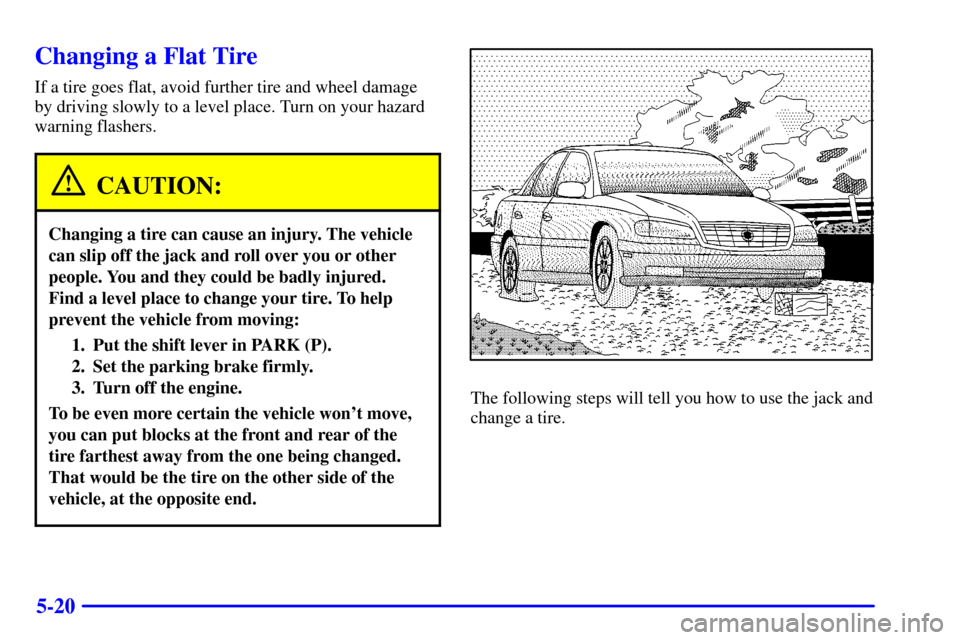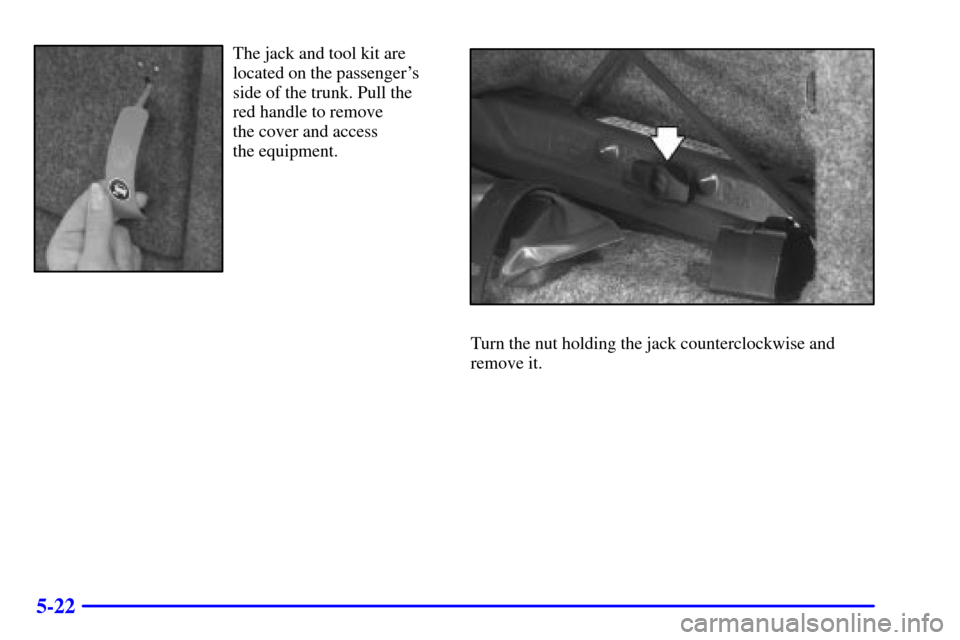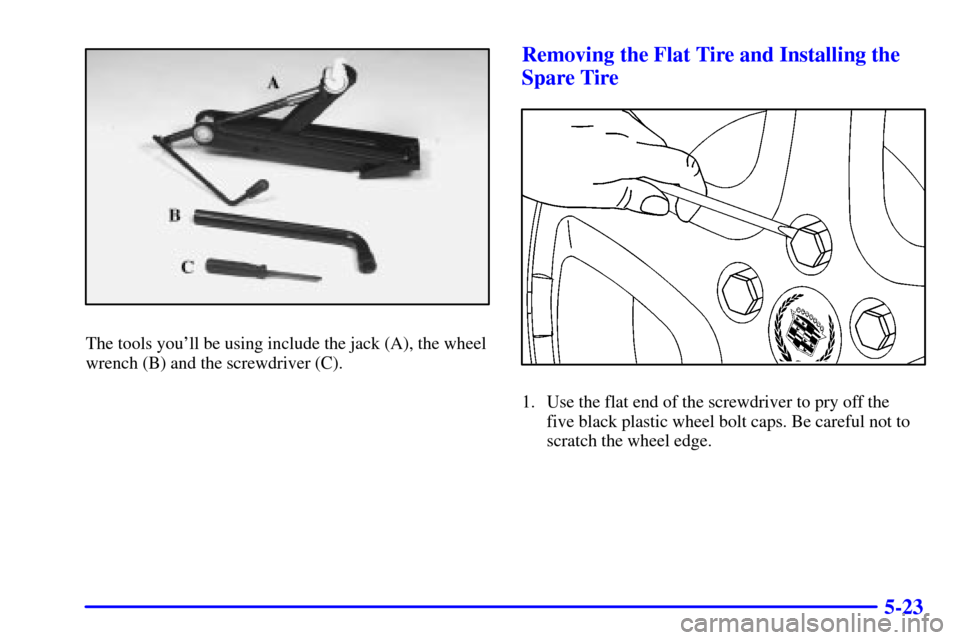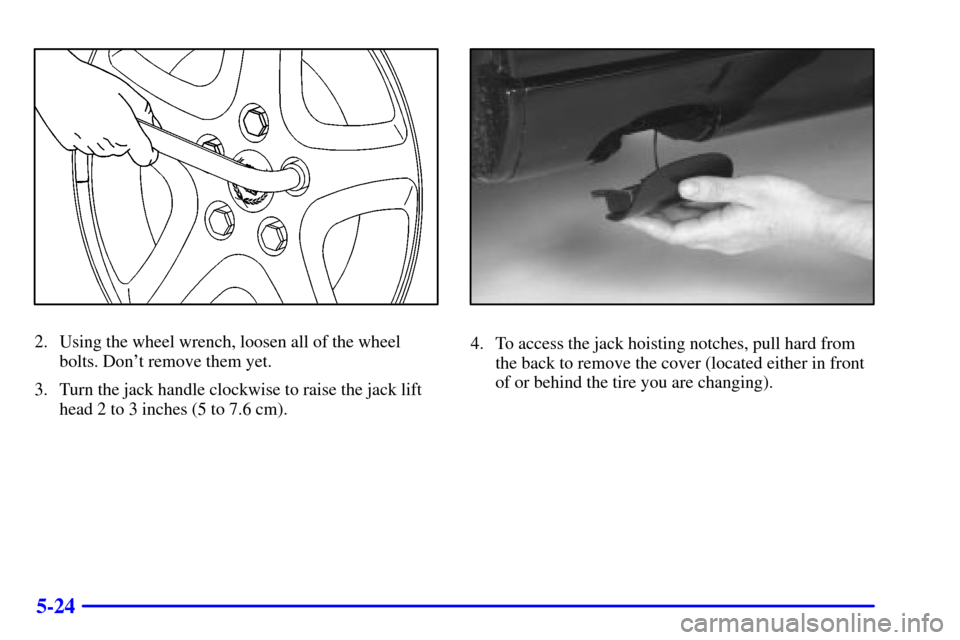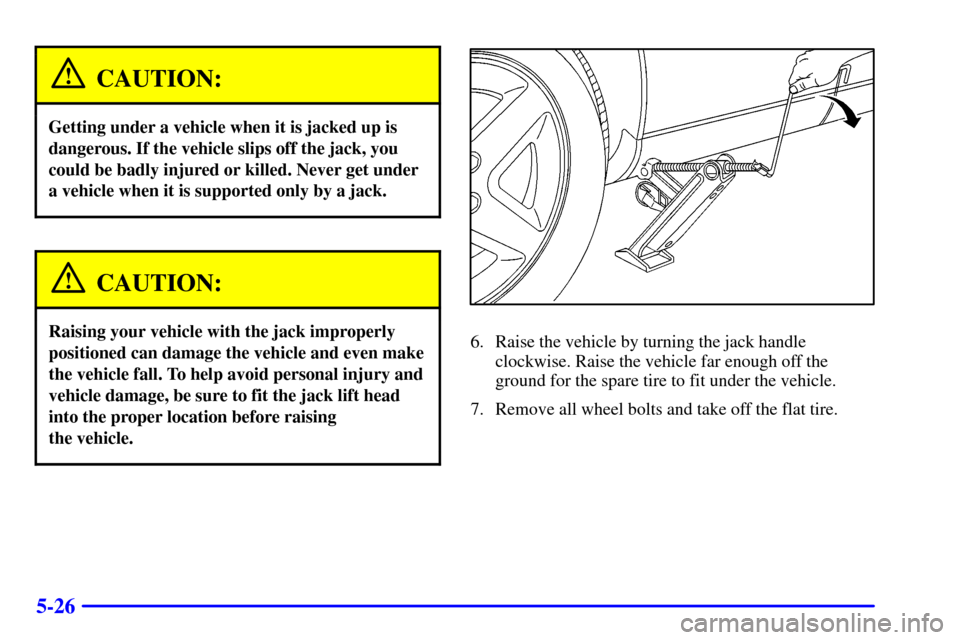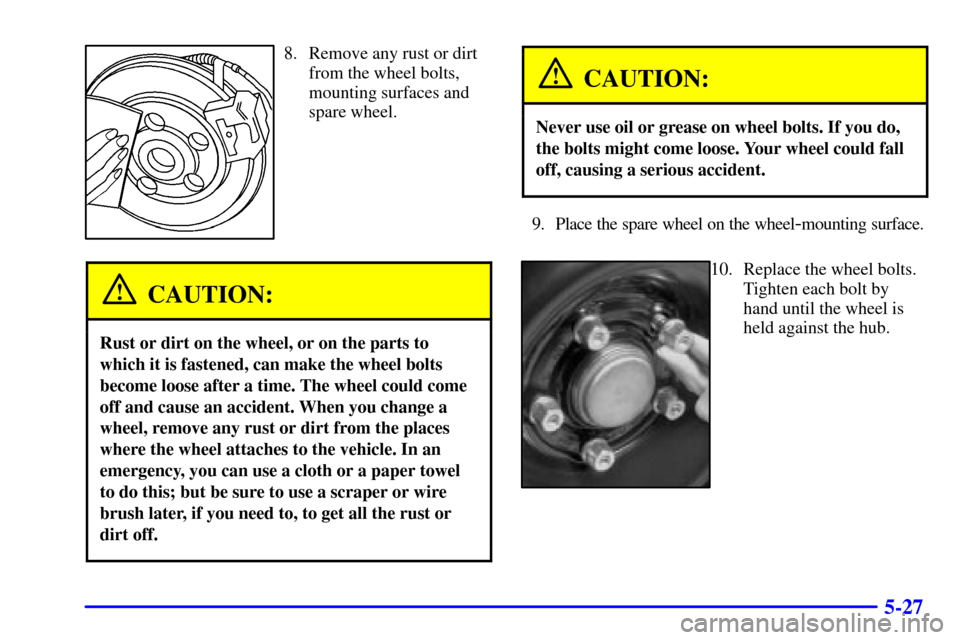CADILLAC CATERA 2000 1.G Owners Manual
CATERA 2000 1.G
CADILLAC
CADILLAC
https://www.carmanualsonline.info/img/23/7854/w960_7854-0.png
CADILLAC CATERA 2000 1.G Owners Manual
Trending: spark plugs, spare tire location, wheel torque, radio controls, wheel, oil filter, lock
Page 231 of 321
5-18
3. Then fill the coolant surge tank with the proper
mixture, to the KALT/COLD line (seam).4. With the coolant surge tank pressure cap off, start
the engine and let it run until you can feel the upper
radiator hose getting hot. Watch out for the engine
cooling fans.
By this time, the coolant level inside the coolant
surge tank may be lower. If the level is lower, add
more of the proper mixture to the coolant surge tank
until the level reaches the KALT/COLD line (seam).
Page 232 of 321
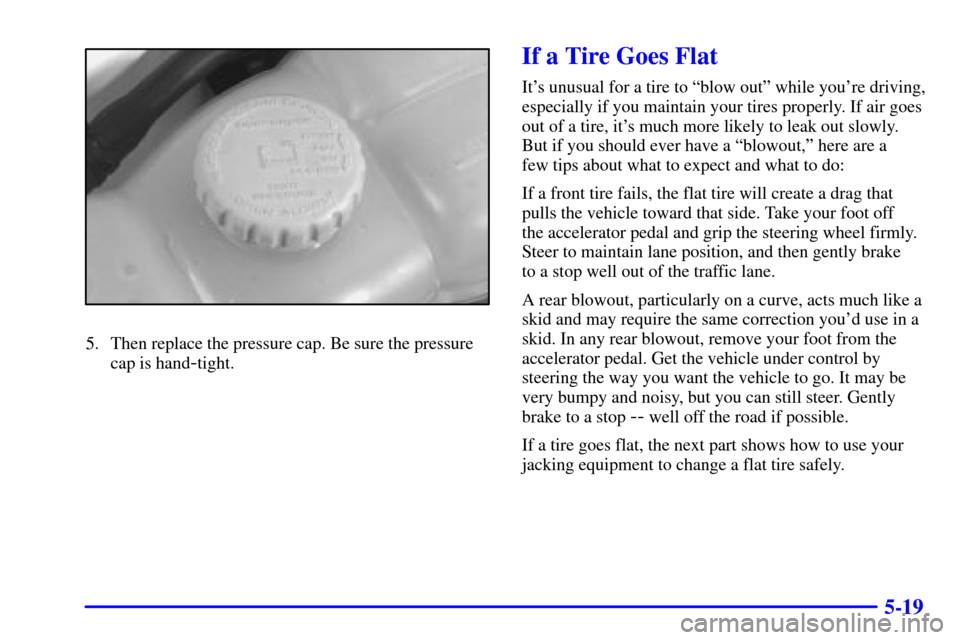
5-19
5. Then replace the pressure cap. Be sure the pressure
cap is hand
-tight.
If a Tire Goes Flat
It's unusual for a tire to ªblow outº while you're driving,
especially if you maintain your tires properly. If air goes
out of a tire, it's much more likely to leak out slowly.
But if you should ever have a ªblowout,º here are a
few tips about what to expect and what to do:
If a front tire fails, the flat tire will create a drag that
pulls the vehicle toward that side. Take your foot off
the accelerator pedal and grip the steering wheel firmly.
Steer to maintain lane position, and then gently brake
to a stop well out of the traffic lane.
A rear blowout, particularly on a curve, acts much like a
skid and may require the same correction you'd use in a
skid. In any rear blowout, remove your foot from the
accelerator pedal. Get the vehicle under control by
steering the way you want the vehicle to go. It may be
very bumpy and noisy, but you can still steer. Gently
brake to a stop
-- well off the road if possible.
If a tire goes flat, the next part shows how to use your
jacking equipment to change a flat tire safely.
Page 233 of 321
5-20
Changing a Flat Tire
If a tire goes flat, avoid further tire and wheel damage
by driving slowly to a level place. Turn on your hazard
warning flashers.
CAUTION:
Changing a tire can cause an injury. The vehicle
can slip off the jack and roll over you or other
people. You and they could be badly injured.
Find a level place to change your tire. To help
prevent the vehicle from moving:
1. Put the shift lever in PARK (P).
2. Set the parking brake firmly.
3. Turn off the engine.
To be even more certain the vehicle won't move,
you can put blocks at the front and rear of the
tire farthest away from the one being changed.
That would be the tire on the other side of the
vehicle, at the opposite end.The following steps will tell you how to use the jack and
change a tire.
Page 234 of 321
5-21 Removing the Spare Tire and Tools
The equipment you'll need is in the trunk. On the
driver's side of the trunk is the spare tire. Pull the
fasteners on the spare tire cover to access the tire.
Unbuckle the tire and lift it up to remove it from
the trunk.
Page 235 of 321
5-22
The jack and tool kit are
located on the passenger's
side of the trunk. Pull the
red handle to remove
the cover and access
the equipment.
Turn the nut holding the jack counterclockwise and
remove it.
Page 236 of 321
5-23
The tools you'll be using include the jack (A), the wheel
wrench (B) and the screwdriver (C).
Removing the Flat Tire and Installing the
Spare Tire
1. Use the flat end of the screwdriver to pry off the
five black plastic wheel bolt caps. Be careful not to
scratch the wheel edge.
Page 237 of 321
5-24
2. Using the wheel wrench, loosen all of the wheel
bolts. Don't remove them yet.
3. Turn the jack handle clockwise to raise the jack lift
head 2 to 3 inches (5 to 7.6 cm).4. To access the jack hoisting notches, pull hard from
the back to remove the cover (located either in front
of or behind the tire you are changing).
Page 238 of 321
5-25
5. Position the jack under the vehicle.The base of the jack must line up vertically with the
hoisting notch (jack contact point) on the vehicle's
frame, nearest the flat tire. Make sure that the base
is flat against the ground in order to have enough
clearance to turn the jack handle. Then, raise the jack
lift head until it is firmly set into the hoisting notch.
Page 239 of 321
5-26
CAUTION:
Getting under a vehicle when it is jacked up is
dangerous. If the vehicle slips off the jack, you
could be badly injured or killed. Never get under
a vehicle when it is supported only by a jack.
CAUTION:
Raising your vehicle with the jack improperly
positioned can damage the vehicle and even make
the vehicle fall. To help avoid personal injury and
vehicle damage, be sure to fit the jack lift head
into the proper location before raising
the vehicle.6. Raise the vehicle by turning the jack handle
clockwise. Raise the vehicle far enough off the
ground for the spare tire to fit under the vehicle.
7. Remove all wheel bolts and take off the flat tire.
Page 240 of 321
5-27
8. Remove any rust or dirt
from the wheel bolts,
mounting surfaces and
spare wheel.
CAUTION:
Rust or dirt on the wheel, or on the parts to
which it is fastened, can make the wheel bolts
become loose after a time. The wheel could come
off and cause an accident. When you change a
wheel, remove any rust or dirt from the places
where the wheel attaches to the vehicle. In an
emergency, you can use a cloth or a paper towel
to do this; but be sure to use a scraper or wire
brush later, if you need to, to get all the rust or
dirt off.
CAUTION:
Never use oil or grease on wheel bolts. If you do,
the bolts might come loose. Your wheel could fall
off, causing a serious accident.
9. Place the spare wheel on the wheel-mounting surface.
10. Replace the wheel bolts.
Tighten each bolt by
hand until the wheel is
held against the hub.
Trending: center console, recommended oil, check transmission fluid, engine, fuel, wiper fluid, manual transmission
